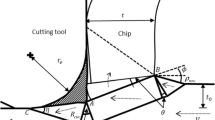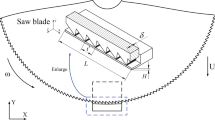Abstract
One of the major issues of drilling operations pertains to the formation of burrs, which greatly influences the accuracy of the manufactured parts, and, thus, the capability to meet the desired performance of the part. To remove or prevent these burrs, their geometry must be measured accurately, even though they are sharp and irregular in shape. The accurate measurement of the geometry of a burr will lead to the development of a proper deburring method. In this work, the authors describe a simple and convenient new measurement technique for drilling burr profiles and a developed drilling burr measurement system based on surface area. The new method presented in this research aims at providing a comparative evaluation of the height, arc length and area of the burr, as well as its geometrical characteristics. When the average height and arc length measurement methods are compared with the area measurement method, large deviations in burr height are detected. In particular, these deviations increase more in non-uniform burrs. In the measurement of burr size, the new developed method is based on area measurement and is carried out using a computer. Therefore, there is no deviation between the measurements. In contrast, the average deviation ranges for the height and arc length measurement methods are found to be 9.94–48.14% and 6.07–18.82%, respectively.









Similar content being viewed by others
References
Davim, J. P., & Jackson, M. J. (2013). Nano and micromachining. New York: Wiley.
Bissacco, G., Hansen, H. N., & De Chiffre, L. (2006). Size effects on surface generation in micro milling of hardened tool steel. CIRP Annals-Manufacturing Technology, 55(1), 593–596.
Bordinassi, É. C., Almeida Filho, C. O. C. D., Stipkovic Filho, M., & Batalha, G. F. (2004). Controle de rebarbação e de forças de corte. Maquinas e Metais, 40(464), 104–119.
Kaminise, A. K. (2004). Estudo da formação de rebarbas no torneamento cilíndrico externo de aço-carbono ABNT 1045.
Fabrizio, M., Marco, S., Stefania, B., & Enrico, S. (2018). Novel method for burrs quantitative evaluation in micro-milling. Precision Engineering, 54, 379–387.
Stein, J. M., & Dornfeld, D. A. (1997). Burr formation in drilling miniature holes. Annals CIRP, 46(17), 63–66.
Parenti, P., Masato, D., Sorgato, M., Lucchetta, G., & Annoni, M. (2017). Surface footprint in molds micro milling and effect on part demold ability in micro injection molding. Journals of Manufacturing Processes., 29, 160–174.
International Standard ISO 13715:2000, Technical drawings—edges of undefined shape—vocabulary and indications.
David, P., Andreas, K., Sophie, V., Ngozi, A., & Mongi, A. (2005). 3D CAD model generation of mechanical parts using coded-pattern projection and laser triangulation systems. Assembly Automation., 25(3), 230–238.
Aurich, J. C. (2006). Untersuchung zur Beherrschung der Sauberkeit von zerspanend hergestellten Bauteilen. Ergebnisworkshop, Lehrstuhl für Fertigungstechnik und Betriebsorganisation, Kaiserslautern Technische Universität.
Leopold, J., & Schmidt, G. (2004). Methods of burr measurement and burr detection. VDI-Berichte, 1860, 223–229.
Aurich, J. C., Dornfeld, D., Arrazola, P. J., Franke, V., Leitz, L., & Min, S. (2009). Burr-analysis, control and removal. CIRP Annals-Manufacturing Technology, 58(2), 519–542.
Kim, W. S., & Sung-Lim, K. (2003). Development of Effective Measurement Method for Burr Geometry. JKSPE, 20(6), 147. (81–87).
Schafer, F. (1975). Entgraten. Mainz: Krausskopfverlag.
Nakao, Y., & Watanabe, Y. (2006). Measurements and evaluations of drilling burr profile. P I Mechanical Engineering B-Journal of Engineering, 220(4), 513–523.
Sokolowski, A. (2010). On burr height estimation based on axial drilling force. Journal of Achievements in Materials and Manufacturing Engineering, 43, 734–742.
Aurich, J. C., Dornfeld, D., Arrazola, P. J., Franke, V., Leitz, L., & Min, S. (2009). Burrs-analysis, control and removal. CIRP Annals-Manufacturing Technolgy, 58, 519–542.
Mondal, N., Sardar, B. S., Halder, R. N., & Das, S. (2014). Observation of drilling burr and finding out the condition for minimum burr formation. International Journal of Manufacturing Engineering, 2014, 208293. https://doi.org/10.1155/2014/208293.
Das, A., & Barik, T. (2014). An experimental study on the burr formation in drilling of aluminum channels of rectangular section. 5th International & 26th All India Manufacturing Technology, Design and Research Conference (AIMTDR 2014) 2014 December 12th–14th. Guwahati: IIT.
Costa, E. S., Silva, M. B., & Machado, A. R. (2009). Burr produced on the drilling process as a function of tool wear and lubricant-coolant conditions. Journal of the Brazilian Society of Mechanical Sciences and Engineering., 31(1), 57–63.
Bi, S. S., & Liang, J. (2011). Robotic drilling system for titanium structures. International Journal of Advanced Manufacturing Technology, 5(8), 767–774.
Niknam, S. A., Zedan, Y., & Songmene, V. (2014). Machining burrs formation & deburring of aluminium alloys. In Light metal alloys applications (pp. 99–122).
Pilny, L., Chiffre, L., Piska, M., & Villumsen, M. F. (2012). Hole quality and burr red in drilling aluminum sheets. CIRP-JMST, 5(2), 102–107.
Hoang, H. P., & Ko, S. L. (2010). Burr measurement systemfor drilled hole at inclined exit surface. In Burrs-analysis, control and removal (pp. 157–165). Berlin: Springer.
Rimpault, X., Chatelain, J. F., Klemberg-Sapieha, J. E., & Balazinski, M. (2017). Burr height monitoring while drilling CFRP/titanium/aluminium stacks. Mechanics and Industry, 18(1), 114.
Melkote, S., Newton, T., Hellstern, C., Morehouse, J. B., & Turner, S. (2010). Interfacial burr formation in drilling of stacked aerospace materials Burrs-analysis, control and removal (pp. 89–98). Berlin: Springer.
Aziz, M., Ohnishi, O., & Onikura, H. (2012). Advanced burr-free hole machining using newly developed micro compound tool. International Journal of Precision Engineering and Manufacturing, 13(6), 947–953.
Qiu, X., Li, P., Li, C., Niu, Q., Chen, A., Ouyang, P., et al. (2019). New compound drill bit for damage reduction in drilling CFRP. International Journal of Precision Engineering and Manufacturing-Green Technology, 6(1), 75–87.
Curtis, G. F., & Patrick, W. O. (2004). Applied Numerical Analysis (7th ed.). London: Pearson.
ENISO‐4287. (1997). Geometrical product specifications (GPS)–surface texture: profile method–terms, definitions and surface texture parameters.
Uriarte, L., Herrero, A., Zatarain, M., Santiso, G., de Lacalle, L. L., Lamikiz, A., et al. (2007). Error budget and stiffness chain assessment in a micromilling machine equipped with tools less than 03 mm in diameter. Precision Engineering, 31(1), 1–12.
Hashimura, M., Hassamontr, J., & Dornfeld, D. A. (1999). Effect of in-plane exit angle and rake angles on burr height and thickness in face milling operation. Journal of Manufacturing Science and Engineering and Technology ASME, 121(1), 13–19.
Park, I. W., & Dornfeld, D. A. (2000). A study of burr formation processes using the finite element method: part II—the influences of exit angle, rake angle, and backup material on burr formation processes. Journal of Engineering Materials and Technology, Transaction of ASME, 122(2), 221–228.
Waqar, S., Asad, S., Ahmad, S., Abbas, C. A., & Elahi, H. (2017). Effect of drilling parameters on hole quality of Ti-6Al-4V titanium alloy in dry drilling. Materials Science Forum, 880, 33–36.
Author information
Authors and Affiliations
Corresponding author
Ethics declarations
Conflict of interest
On behalf of all authors, the corresponding author states that there is no conflict of interest.
Additional information
Publisher's Note
Springer Nature remains neutral with regard to jurisdictional claims in published maps and institutional affiliations.
Rights and permissions
About this article
Cite this article
Bahçe, E., Özdemir, B. Burr Measurement Method Based on Burr Surface Area. Int. J. of Precis. Eng. and Manuf.-Green Tech. 8, 1287–1296 (2021). https://doi.org/10.1007/s40684-020-00228-0
Received:
Revised:
Accepted:
Published:
Issue Date:
DOI: https://doi.org/10.1007/s40684-020-00228-0




